Annually, the unveiling of fresh scientific research and archaeological findings provides us more insight into human history. Specialists have unearthed long-forgotten civilizations, previously unknown religious practices, and rare species that once inhabited the planet. You don’t have to emulate Indiana Jones to appreciate an intriguing archaeological enigma. Significant archeological discoveries like Peru’s Nazca Plains or the perpetual puzzle of Stonehenge have made a significant impact on global awareness, yet countless other less famous discoveries and minute artifacts persist in piquing the curiosity and baffling experts.
Today’s list looks at 25 Mysterious Archeological Artefacts ever discovered.

The Ica Stones
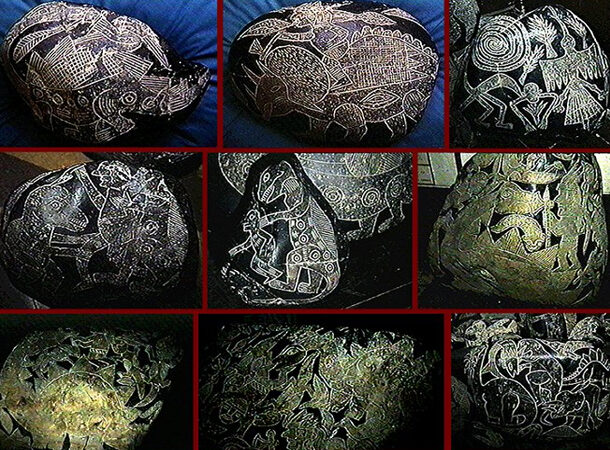 https://www.ancient-hebrew.org/ancientman/1001.html
https://www.ancient-hebrew.org/ancientman/1001.html Our first two entries on today’s list are incredibly controversial. The Ica stones are unusual and eye-catching stones from Dr. Javier Carbrera’s collection. While many still argue about the stones’ authenticity, they are believed to range from 500 to 1,500 years old. Some contain sexually explicit visuals, while others seem to depict idols and what looks like brain transplant or open-heart surgery imagery. One of the most discussed images is that of dinosaurs. The Ica stones are sealed with a natural varnish that accumulated over hundreds or thousands of years. When the engravings on the stone were studied, it was discovered that the varnish was present on them as well, indicating that they are likewise of ancient origin. Because of the large number of these stones, it would be extremely difficult for one person to create all of them quickly. However, the finding of other stones beneath a house erected in the 1920s is the most conclusive evidence that these stones might be authentic.
The Dropa Stones
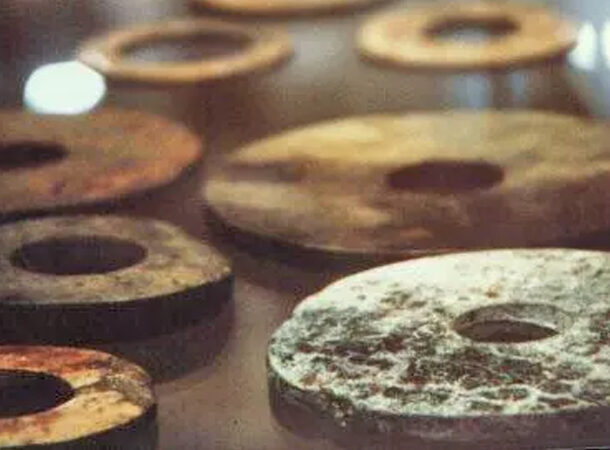 https://www.ancient-code.com/the-mysterious-12000-year-old-dropa-stones-evidence-of-ancient-alien-contact/
https://www.ancient-code.com/the-mysterious-12000-year-old-dropa-stones-evidence-of-ancient-alien-contact/ The Dropa stones’ history and mystery date back to 1938. The stones are the subject of much debate and unanswered questions. Said to have been discovered among the graves of an unfamiliar race, the stones remain an unexplained archaeological find. Because the stones belong to the Chinese, research on them has been limited, and it’s entirely possible that the stones are connected to the ancient beliefs of a tribe of diminutive dwarfish people. The race is, in fact, just as mysterious as the stones. The Russians grew interested in the Dropa stones over time and asked for and gained permission to conduct additional research on them. Some of the stone discs were sent to Moscow to be studied. According to the findings of this study, the stones included a high concentration of cobalt and other metallic elements. What’s more remarkable is that the stones oscillated as if they had an electrical charge. At least one expert believes the stones are linked to an ancient electric circuit.
The Jade Discs
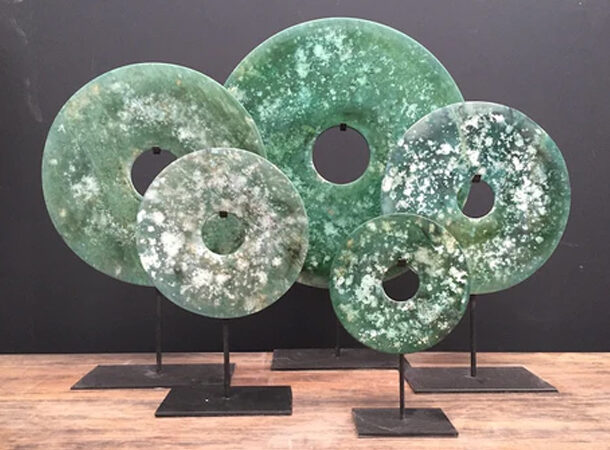 https://www.ancient-origins.net/unexplained-phenomena/mysterious-origin-jade-discs-00943
https://www.ancient-origins.net/unexplained-phenomena/mysterious-origin-jade-discs-00943 The Jade discs are flattened circular rings created in China during the Late Neolithic period. They appear to have been of enormous value because they were generally put on the bodies of nobles and have been found in practically every single significant tomb of the Hongshan civilization, which lasted from 3800 BC to 2000 BC. Given that they were created out of Jade, an extraordinarily hard rock, it is puzzling why China’s ancient Neolithic inhabitants picked this material, given that metal instruments and tools were not available at the time. Some archaeologists believe they were manufactured by brazing and polishing, but that would have taken those who created them an extremely long time. Others believe that the appearance of the Jade discs is related to the strange mystery of the Dropa stones that were discovered in a cave along the China-Tibet border before the Jade Discs. For now, their purpose and significance remain unexplained.
Roman Dodecahedrons
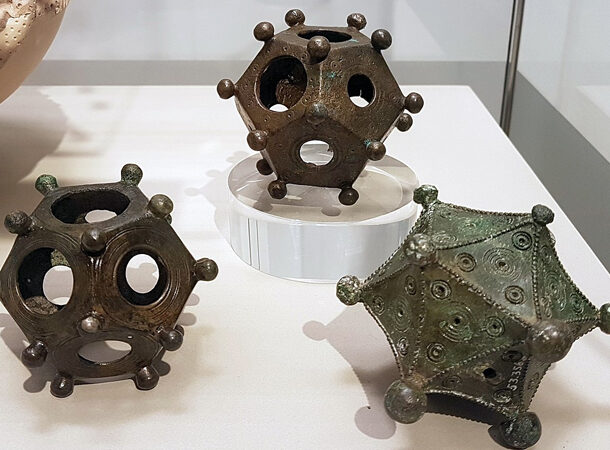 https://bigthink.com/strange-maps/roman-dodecahedrons/
https://bigthink.com/strange-maps/roman-dodecahedrons/ Roman Dodecahedrons are common in Europe and have been discovered in France, Spain, Germany, Wales, Hungary, and Italy. All dodecahedrons found to date are hollow in the middle and made of bronze or stone. Even though we’ve known about them since 1739, when the first one was discovered, we have yet to determine what they are or were used for. However, many have theorized that they could have been used as a form of currency. They are from four to eleven centimeters in size and date between 100 and 300 AD, and archeologists have found no mention of them in any existing Roman writings or painted iconography. Theories around their purpose also include grain calendars, religious artifacts, games, and fortune-telling devices.
The Quipu of Caral
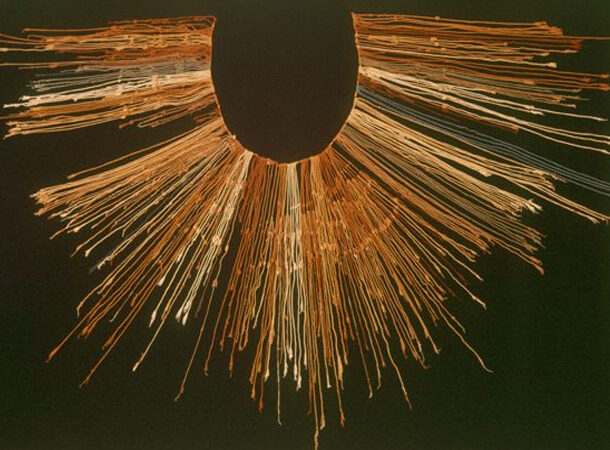 https://gogeometry.com/incas1/quipu/caral_oldest_quipu.html
https://gogeometry.com/incas1/quipu/caral_oldest_quipu.html Caral is one of the world’s most incredible ancient cities and can be found in modern-day found in Peru. A UNESCO World Heritage Site, one would never guess that one of the most significant finds in the city would be an ancient quipu. A quipo was a complicated knot and string arrangement used to convey comprehensive information. The one discovered at Caral was discovered to be over 5000 years old, demonstrating that quipos were used thousands of years earlier than previously thought. Up to its discovery, the oldest known quipus dated from around 650 AD and was generally connected with the Incas, whose enormous South American empire was captured by the Spanish in the 16th century.
Although the events of each marked moment on the Caral quipu will never be revealed, the color, knot placement, and type of cord all contribute to its logical, numerical reading. Although they were common in ancient times, only a few survived.
The Babylonian Map of the World
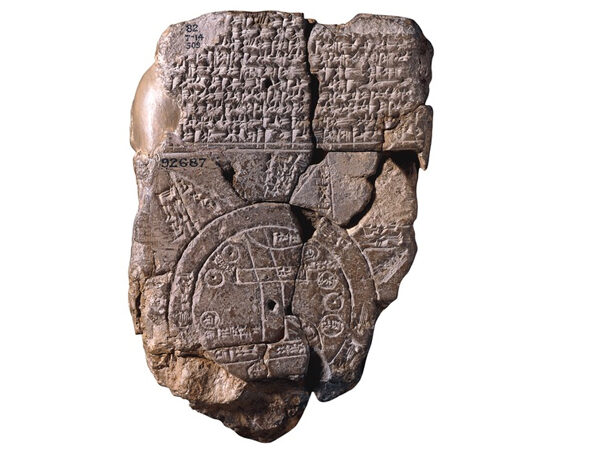 https://www.thearchaeologist.org/blog/imago-mundi-the-oldest-known-map
https://www.thearchaeologist.org/blog/imago-mundi-the-oldest-known-map The Babylonian Map of the World is a clay tablet constructed in 5 BC. It is the world’s oldest known map, and it includes map descriptions in the now-lost Babylonian written language. Travel was limited in ancient times, yet history has proved that our forefathers were more mobile than you might think. The Euphrates River, vital to their existence, is depicted in the map’s center. The map is believed to have been created to portray every aspect of the universe. It is remarkable in that it includes islands that extend beyond the ocean. The actual significance of the map’s content remains a mystery as some believe the map is designed to depict the Babylonian view of the mythological world. The 18 mythical beasts described in the map’s lettering allude to the Babylonian Epic of Creation, which represents the creation of the new world after the mythological animals were expelled to the “Heavenly Ocean.”
The Hidden Treasures in Utah
 https://www.smithsonianmag.com/history/secrets-of-the-range-creek-ranch-110879163/
https://www.smithsonianmag.com/history/secrets-of-the-range-creek-ranch-110879163/ Like his father before him, Utah rancher Waldo Wilcox and his entire family kept quiet about the old pit homes, prehistoric rock lines, drawings, and stone tools scattered throughout their 4,000-acre Range Creek property for years. The artifacts were left by a mysterious group known as the Fremont Indians who lived in the area 1,000 years ago, and they stayed predominantly undisturbed due to the Wilcox’s gates and “road closed” signs, which were set up to deter hunters. After Waldo’s health deteriorated, he sold the ranch to the Bureau of Land Management, and it is now managed by the Utah Museum of Natural History. The ancient settlements on the ranch remain largely unexplored and unexcavated to this day.
The Advanced Stone-Age Tools
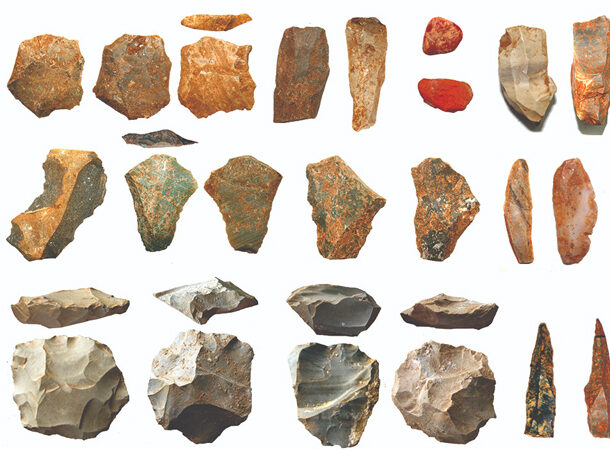 https://www.newscientist.com/article/2159990-someone-made-advanced-stone-tools-in-india-172000-years-ago/
https://www.newscientist.com/article/2159990-someone-made-advanced-stone-tools-in-india-172000-years-ago/ According to genetic data, more than 90% of modern humans are descended from a small group of Homo sapiens that left Africa around 60,000 years ago. Researchers believe the group’s success was due to the development of improved stone tools—fine stone blades that could have been used on the points of spears rather than unwieldy hand axes. However, a site in southern India, where ancient human settlements have not been extensively explored, suggests that people developed sophisticated tools more than 200,000 years ago. Archeologists do not know if this indicates that our ancestors left Africa in phases or if other hominids evolved similar developments independently.
Medieval Maternity
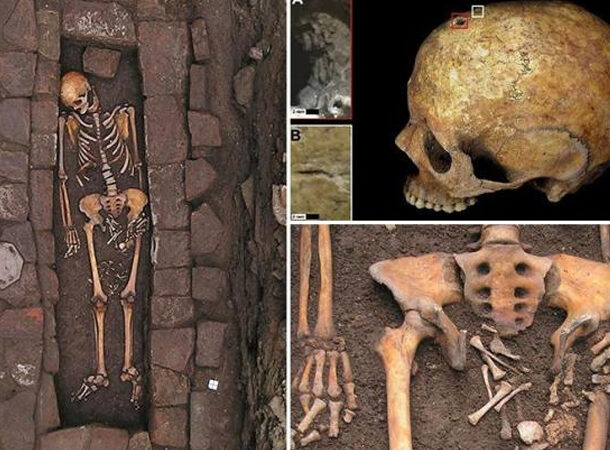 https://www.smithsonianmag.com/smart-news/rare-case-coffin-birth-seen-medieval-grave-180968612/
https://www.smithsonianmag.com/smart-news/rare-case-coffin-birth-seen-medieval-grave-180968612/ Around 1,300 years ago, a woman in the Italian town of Imola died just a few weeks before she was due to give birth. Upon finding her grave, Archaeologists discovered the skeleton of her fetus between her legs, a rare case of a “coffin birth,” which happens when gases build up inside a pregnant woman’s body, causing the fetus to be pushed through the birth canal after death. However, apart from the coffin birth, archeologists were more intrigued by another unexpected discovery: a small hole had been made in the mother’s skull before she died. Drilling such a hole is known as trepanation, and it has been used throughout history and around the world to cure head injuries and headaches and possibly to ward off evil spirits. In this case, researchers wonder if she had preeclampsia or eclampsia – pregnancy-related disorders characterized by extremely high blood pressure and potential seizures.
The Venus Figurines
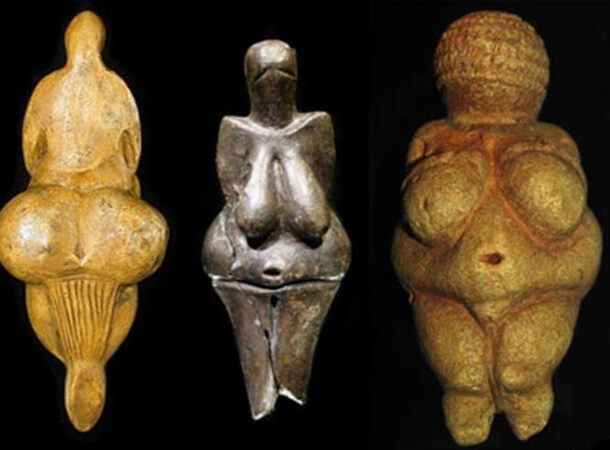 https://www.hindawi.com/journals/janthro/2011/569120/
https://www.hindawi.com/journals/janthro/2011/569120/ The Venus figurines are a group of prehistoric female sculptures from the Palaeolithic period. Over 200 statues have been discovered, mainly in Europe and Siberia. They all have the same physical characteristics, such as sensuous forms with enormous chests, posteriors, bellies, and thighs, dating back to 30,000 and 10,000 BC. Their heads are typically tiny and devoid of detail; many lack feet and hands. There is a vast difference of opinion in archaeological and paleoanthropological studies about these artifacts’ likely roles and significance. Some of the hypotheses include that these sculpted objects were created to serve as fertility symbols, that they could have been self-portraits, that they were simply Stone Age dolls, or that they could have been realistic representations of ordinary women, religious images, ideal representations of female sexuality, or even an ancient pornographic imagery counterpart. For now, the mystery endures.
The Cochno Stone
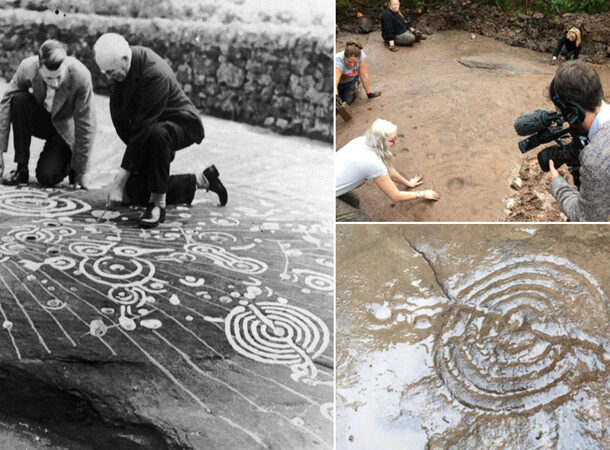 https://theorkneynews.scot/2022/08/20/the-amazing-cochno-stone-scottish-prehistoric-rock-art/
https://theorkneynews.scot/2022/08/20/the-amazing-cochno-stone-scottish-prehistoric-rock-art/ We promise the following entry covers the last mysterious stone. In 2016, archaeologists uncovered a 5,000-year-old stone slab with a very mysterious history. The so-called Cochno Stone is 43 feet by 26 feet (13 by 8 meters) in size and has whirling designs all over its surface known as “cup and ring marks” that have also been found at various other prehistoric sites around the world. According to some, the slab could represent an example of ancient artwork. Archeologists who examined the Concho Stone in the 1930s thought the writings were related to astronomical occurrences such as eclipses. However, the research continues to determine how and why prehistoric people used it.
The Piri Reis Map
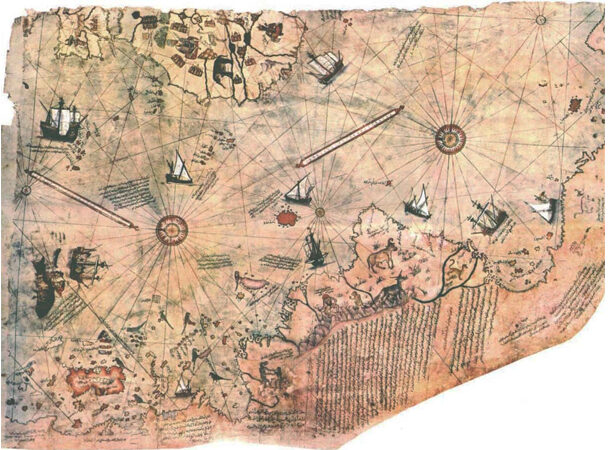 https://www.thevintagenews.com/2018/01/02/piri-reis-map-of-1513/
https://www.thevintagenews.com/2018/01/02/piri-reis-map-of-1513/ In 1929, German archeologists discovered an ancient map in the Topaki Palace Library in Istanbul. The map was drawn on gazelle skin in 1513 by a prominent and well-documented admiral of the Turkish fleet named Piri Reis. In an annotation, the admiral wrote that the map was built around information he obtained on various other and older Spanish, Portuguese, and Arabic maps, including some produced by the famous explorer Christopher Columbus. The surviving fragments display different regions of the world as mapmakers perceived it in the 15th century and show all the identified landmasses but come with one unanswered mystery. It displays the northern coast of Antarctica along its bottom section, which historians maintain was not discovered until 1773.
To make matters worse, the continent is linked to South America and is no longer covered in ice, as it has been for the last 6,000 years. Several historians have argued that the portrayal of Antarctica is accurate and matches the continent’s configuration before it became covered with ice.
Phaistos Disc
 https://www.ancient-origins.net/unexplained-phenomena/curious-phaistos-disc-ancient-mystery-or-clever-hoax-002089
https://www.ancient-origins.net/unexplained-phenomena/curious-phaistos-disc-ancient-mystery-or-clever-hoax-002089 The Phaistos Disc, an ornate fired-clay disc with a spiral of symbols imprinted on both sides, has been seen as anything from a prayer to a poem or even (possibly) a curse. It is a mystery to the archaeological community and has divided opinion since its discovery in 1908. Everything from the meaning and purpose of the Phaistos Disc to its origins and production, written in a language no one can identify or read, is a source of intense controversy. Some even believe this controversial artifact, housed in the Heraklion Archaeological Museum, is fake.
This artifact’s notoriety stems mainly from the mysterious markings inscribed on both sides. Experts have not only struggled to comprehend their meaning but also the language in which they are written. There are 242 hieroglyph-like images in total, with 45 different symbols, dashes, and dots. The images include people, plants, and animals. A bell, a wandering man, and a cat head are among the most common glyphs.
The Voynich Manuscript
 https://undark.org/2020/02/12/decoding-bizarre-voynich-manuscript/
https://undark.org/2020/02/12/decoding-bizarre-voynich-manuscript/ One of the most talked-about books of the twentieth century was an ancient document that no one could read. The Voynich manuscript, discovered by an antique bookseller in 1912, is a 250-page manuscript written using an unknown alphabet and adorned with imagery ranging from female nudity to therapeutic herbs and Zodiac signs. According to scholars, this manuscript, now in Yale University’s Beinecke Rare Manuscript & Manuscript Library, was most likely written in Central Europe 600 years ago. Some researchers believe the book is a Renaissance-era fake filled with nothing more than obscure phrases, while others believe the text was composed in a previously unidentified language. Others say the book contains some kind of code that still needs to be deciphered.
The Nebra Sky Disk
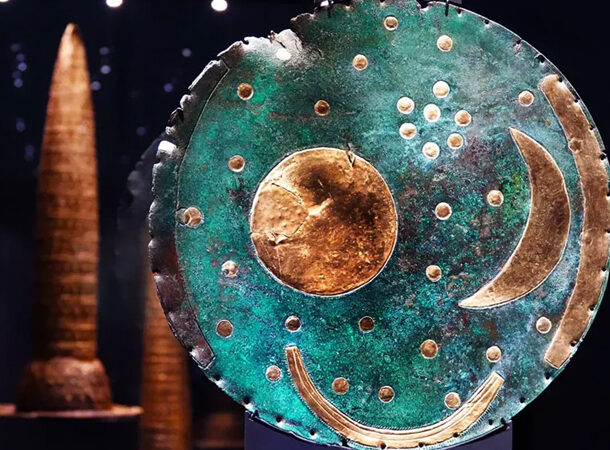 https://www.worldhistory.org/article/235/the-nebra-sky-disk---ancient-map-of-the-stars/
https://www.worldhistory.org/article/235/the-nebra-sky-disk---ancient-map-of-the-stars/ The Nebra Sky Disc has sparked significant controversy since its discovery in 1999. From the looters who first discovered the artifact with metal detectors through the subsequent court hearings, ongoing disagreement amongst archaeologists, and charges of revenge, the disc has become one of Germany’s most celebrated prehistoric objects. Many researchers believe it is the oldest known accurate map of the stars, possibly even an early clock used to determine planting and harvesting times. Looters allegedly discovered the artifact in 1999 near Nebra, Germany, and tried to sell it on the black market. Historians continue to investigate the artifact’s origins and history to this day due to various contradictions in the looter’s tales about how it was obtained. Still, it is believed to date from the Bronze Age, some 3,500 years ago.
The Ark of the Covenant
 https://www.pbs.org/wonders/Episodes/Epi4/4_retel1.htm#:~:text=According%20to%20Ethiopian%20tradition%2C%20the,spoken%20to%20it%20in%201691.
https://www.pbs.org/wonders/Episodes/Epi4/4_retel1.htm#:~:text=According%20to%20Ethiopian%20tradition%2C%20the,spoken%20to%20it%20in%201691. Although our next entry hasn’t been discovered, it makes its way onto today’s list as it may be less “hidden” than commonly believed. According to the Book of Exodus, the Ark of the Covenant, a gold-encrusted chest, holds the stone tablets that contain the ten commandments. The sacred chest was stored in the First Temple until the temple was destroyed in 587 B.C. by a Babylonian army led by King Nebuchadnezzar II. Apart from Indiana Jones, nobody knows where it ended up. According to some historical accounts, the Ark arrived in Babylon following Nebuchadnezzar’s destruction of the city. According to some historians, the Ark was buried in Jerusalem or was destroyed along with the First Temple. More recently, it has been rumored that the Ark has never been missing and that it is, in fact, housed in an Ethiopian monastery.
The Copper Scroll Treasure
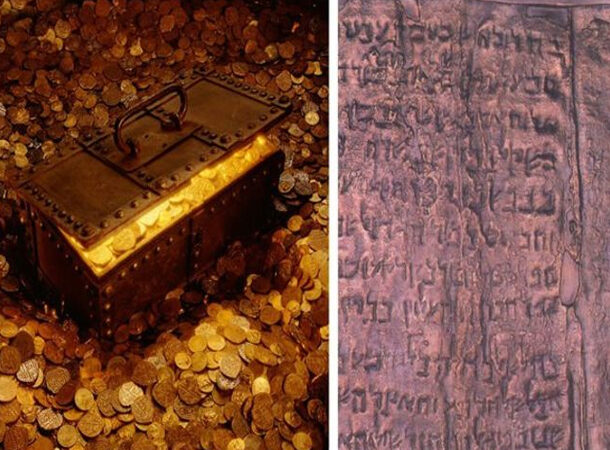 https://dornsife.usc.edu/wsrp/copper-scroll/#:~:text=Sounding%20like%20something%20out%20of,lain%20for%20nearly%202%2C000%20years.
https://dornsife.usc.edu/wsrp/copper-scroll/#:~:text=Sounding%20like%20something%20out%20of,lain%20for%20nearly%202%2C000%20years. Our following entry is an archaeological mystery we’d LOVE to solve: An ancient copper scroll discovered at Qumran in 1952 describes a large amount of hidden gold and silver (to the value of around three TRILLION dollars today), but absolutely nobody knows where that treasure is or whether it even exists. The copper scroll was discovered among the Dead Sea Scrolls in what is now the Palestinian territory of the West Bank. It dates back approximately 2,000 years to when the Roman Empire ruled over the Qumran settlement. According to archeologists, the scroll may describe a treasure that locals hid to keep it out of the clutches of Roman forces during the region’s periodic revolts against the empire.
The Shroud of Turin
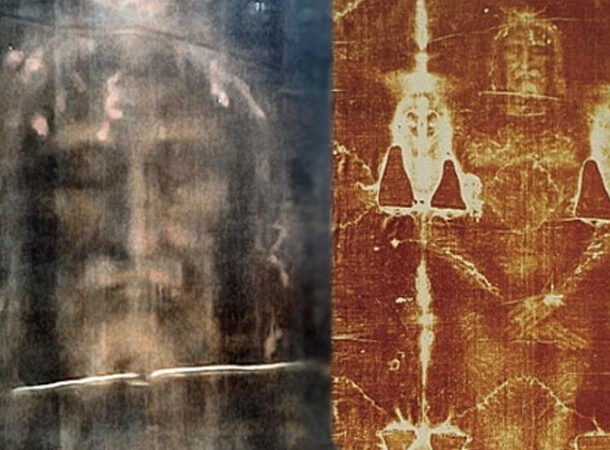 https://www.livescience.com/52567-shroud-of-turin-dna.html
https://www.livescience.com/52567-shroud-of-turin-dna.html Perhaps no archaeological find is more contentious than the mysterious Shroud of Turin, which many believe is the burial shroud of Jesus Christ. This long twill cloth is stained with blood and displays a darker image of a man’s body. The shroud was first mentioned by the Catholic Church in 1353, when it was discovered in a church in Lirey, France. However, the shroud legend dates back to A.D. 30 or 33. The shroud was said to have been transferred from Judea (now southern Palestine) to Edessa, Turkey, and then to Constantinople (now Istanbul).
When crusaders destroyed Constantinople in A.D. 1204, the cloth was taken to Athens, Greece, and stored there until A.D. 1225. It wasn’t until the 1980s that researchers obtained the cloth to use radiocarbon dating to determine its true age. They determined that the burial shroud was made between A.D. 1260 and A.D. 1390. However, some critics of this study argue that the scientists could have dated newer pieces of the shroud stitched together many years after Jesus’ death, explaining why the shroud appears “newer” than it is.
Tiny Human or Tiny Alien?
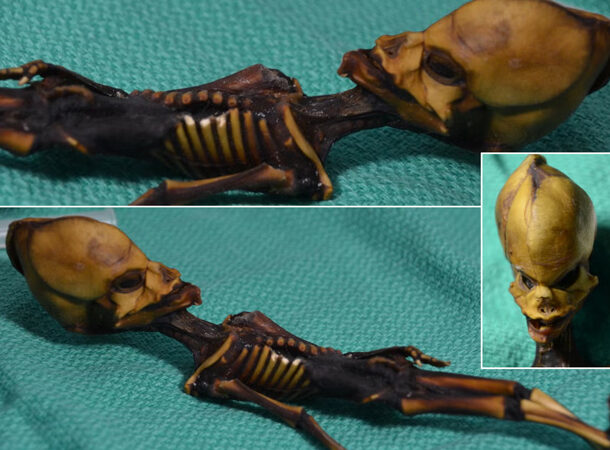 https://edition.cnn.com/2018/03/22/health/atacama-skeleton-mystery/index.html
https://edition.cnn.com/2018/03/22/health/atacama-skeleton-mystery/index.html In 2003, a mummified skeleton with a pointed head was discovered in the Chilean Atacama Desert. The tiny skeleton immediately stupefied everyone who came into contact with it. Preliminary estimations of the age of the bones put it between 6 and 8 years old, but it stood only 6 inches tall. The tall, angular head, slanted eye sockets, and fewer ribs than normal – 10 pairs rather than 12 – further added to the mystery. Although many people thought that the skeleton, which had bone density typical of a 6-year-old despite its small stature, was an alien, scientists were able to sequence and examine its DNA.
Ata, as the female mummy is known, turned out to be a human being. She was descended from indigenous Chileans but also had some European ancestors. Researchers discovered seven separate abnormalities in her growth genes and remain unsure which caused her skeletal abnormalities.
The Seals of Indus Valley Civilization
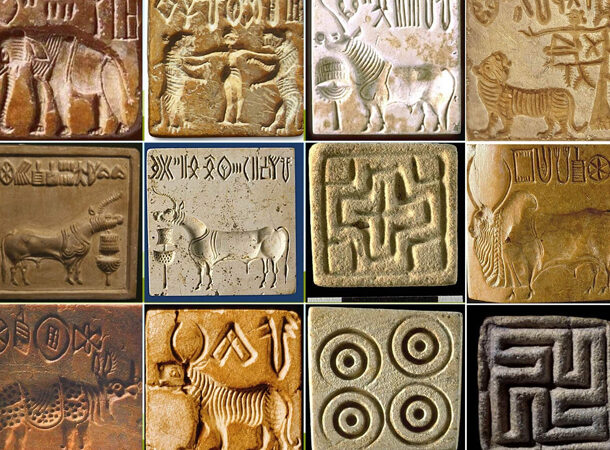 https://mapacademy.io/the-unicorn-seals-an-indus-valley-mystery/
https://mapacademy.io/the-unicorn-seals-an-indus-valley-mystery/ Around the time the pyramids were being erected in Egypt, a “godless” contemporary city was materializing on the Indian subcontinent. So many unsolved mysteries surround the Indus Valley civilization and its magnificent cities, including the cause of their demise in the second millennium B.C. Seals discovered in 1870 led scientists to discover an entirely new civilization in the Indus Valley. Archaeologists uncovered numerous new and previously undiscovered items and riches during the excavation.
The existence of seals indicates that the society traded far and wide. As a result, they would have impacted (and been influenced by) countless other ancient communities. Several seals have been discovered; they are typically square, with symbols on the top and bottom, and have an animal in the center.
The Antikythera Mechanism
 https://www.scientificamerican.com/article/an-ancient-greek-astronomical-calculation-machine-reveals-new-secrets/
https://www.scientificamerican.com/article/an-ancient-greek-astronomical-calculation-machine-reveals-new-secrets/ Around 2000 years ago, A Greek ship sank off the shore of the island of Antikythera and rested undisturbed on the sea floor until it was unearthed in 1900. While sorting through the artifacts recovered from the wreck, archaeologists stumbled upon an object that puzzled them – it had numerous layers of brass gears exactly fitting together and was fashioned into a wooden box. Half a century later, a science historian discovered that the ancient device could, in fact, predict star and planet positions based on date.
Since the first discoveries, we’ve also come to know that Greek text was found on the artifact and that it can, in fact, also forecast eclipses, moon phases, and sporting events such as the Olympics. The Antikythera mechanism continues to be one of the most mysterious inventions from the ancient world, as it was way ahead of its time.
King Tut’s Meteorite Dagger
 http://www.history.com/news/researchers-say-king-tuts-dagger-was-made-from-a-meteorite
http://www.history.com/news/researchers-say-king-tuts-dagger-was-made-from-a-meteorite Since its discovery in 1922, the young pharaoh Tutenkamun and his incredible burial site have captured curiosity and imagination. Three years after the discovery, King Tut still had a few aces up his sleeve, so to speak. Scientists investigating the mummy discovered two daggers within his wrappings. A gold dagger was found near his abdomen, while an iron dagger was discovered near his hip. The latter caught historians’ attention, as iron was extremely scarce during the Bronze Age, when King Tut lived, died, and was mummified.
The mystery would endure for nearly a century. In 2016, Italian researchers examined the blade’s nickel, iron, and cobalt composition and concluded that the blade is of extraterrestrial origin, having been fashioned from one of 11 meteorites recovered in the Egyptian Kingdom during Tut’s reign. Because of the dagger’s rarity and worth, it was most likely only used ceremonially.
The Judean Stone Masks
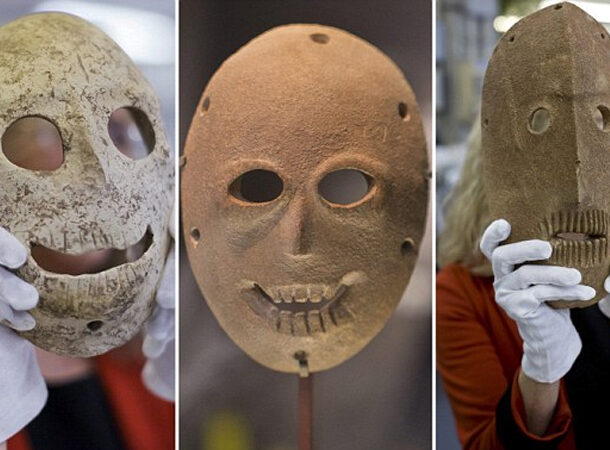 https://www.nationalgeographic.com/culture/2018/11/neolithic-stone-mask-discovery-archaeology-forgery/
https://www.nationalgeographic.com/culture/2018/11/neolithic-stone-mask-discovery-archaeology-forgery/ The 9,000-year-old stone masks excavated and discovered in Judea’s southern desert are some of the most stunning ancient artifacts ever found in the region. To put their ages in context, King Solomon is thought to have lived around 3,000 years ago. Abraham lived over 1,000 years before that, making these relics the world’s oldest ceremonial treasures. In addition to their age, they are extremely rare: only 16 have been authenticated as genuine and are known to exist.
Most have been found in private collections and have hazy origins without archeological background. However, the ancient Neolithic stone masks are historically significant since they were constructed at a time in history when humans first began to organize themselves into communities. The specific function of these masks in society 9,000 years ago remains a mystery.
The Ubaid Lizards
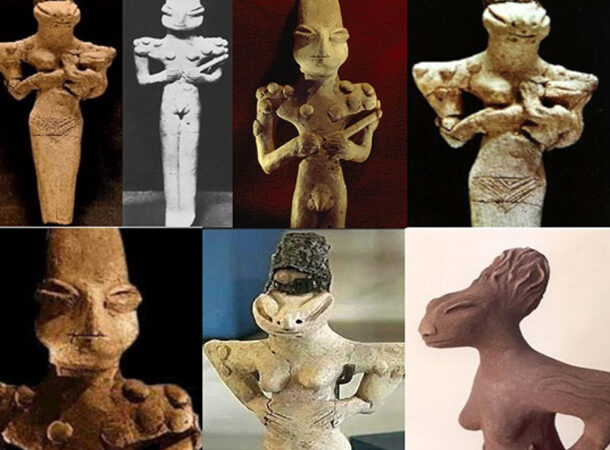 https://weird-history-facts.com/the-ancient-reptilian-ubaid-lizardmen/
https://weird-history-facts.com/the-ancient-reptilian-ubaid-lizardmen/ It is widely acknowledged in conventional archaeology that civilization began in ancient Mesopotamia with the great Sumerian civilization in modern-day Iraq. As such, archeologists were stunned when, in the early 1900s, they uncovered several 7,000-year-old statues at the Tell Al’Ubaid archeological site in Iraq depicting humanoid creatures with lizard-like features such as elongated heads, small curved faces, and amygdaloid eyes. Left behind by the Ubaid culture, which predates the Sumerians, the discovery, not to mention the sculptures’ reptilian features, led to wild theories & interpretations, with unfortunately little evidence to support most of them. (Of course, no written sources from the Ubaid period exist today).
The origins of the Ubaidians, like those of the Sumerians, have yet to be discovered. They lived in vast settlements, drained fertile wetlands, expanded trade, and established various industries, including leather and metallurgy, brickwork, ceramics, and weaving. The Ubaid culture made significant advances in language and writing, architecture, and even politics, setting the groundwork for modern life. Do the sculptures hint at alien involvement in our ancient history? We’ll probably never know.
The Flood Tablet
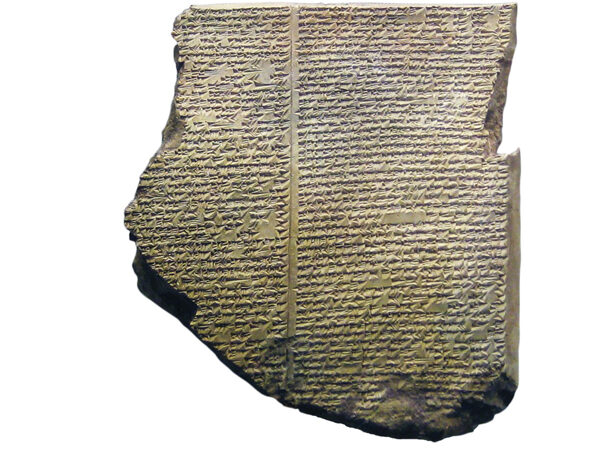 https://www.smithsonianmag.com/science-nature/evidence-for-a-flood-102813115/
https://www.smithsonianmag.com/science-nature/evidence-for-a-flood-102813115/ From possible ancient lizard men to an even older artifact, the Flood tablet. The flood tablet, which was created over 9000 years ago in the 7th century BC, is the most famous of all cuneiform tablets. It’s the eleventh tablet in the Gilgamesh Epic and describes how the gods destroyed the earth with a flood. Like Noah, Utnapishtim had been warned of the impending flood and built an ark that could hold and protect living things. Following the flood, he dispatched birds to search for dry land.
Aside from biblical texts, numerous other ancient religious systems and religions taught about a vast, destructive flood at some point in early human history. Is this tablet the evidence that such a flood occurred, and the flood legends are all retellings of an even older event? It has been demonstrated that a myth is often a faded memory of an actual event. Details may have been added, lost, or forgotten during the telling and retelling, but the essence remains.



























